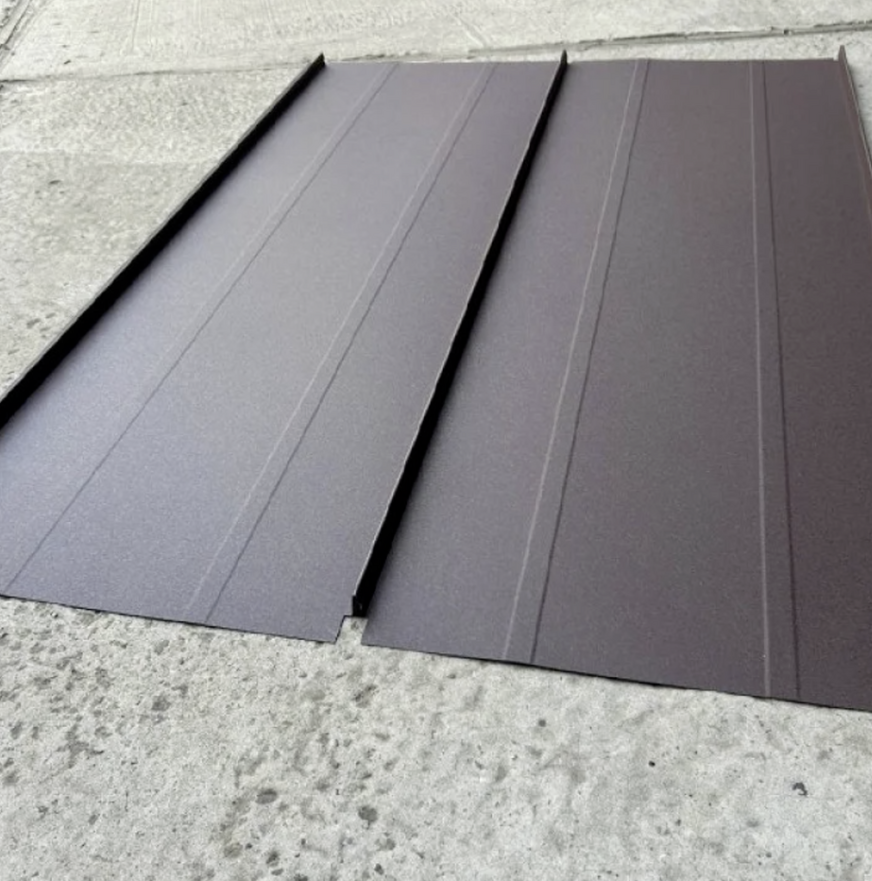Snaplock standing seam panels are a versatile and visually striking roofing and cladding solution, offering a balance of functionality and aesthetic appeal.
Material Options for Snaplock Standing Seam Panels
- Aluminum
- Properties: Lightweight, corrosion-resistant, and durable.
- Advantages: Ideal for coastal or high-humidity areas due to its natural resistance to rust and saltwater corrosion.
- Finishes: Often available in a variety of colors with powder coating or anodizing for enhanced durability and aesthetics.
- Applications: Used in residential, commercial, and industrial projects, especially in regions with harsh weather conditions.
- Steel
- Properties: Strong and cost-effective, with excellent structural integrity.
- Advantages: Available in galvanized or Galvalume® finishes for improved corrosion resistance.
- Finishes: Pre-painted steel panels provide a wide range of color and texture options.
- Applications: Commonly used in industrial buildings and modern residential designs.
- Zinc
- Properties: Durable, self-healing (patina formation), and environmentally friendly.
- Advantages: Requires minimal maintenance and develops a unique patina over time, enhancing its aesthetic appeal.
- Finishes: Often left unpainted to showcase its natural color or treated to control patina development.
- Applications: Popular in high-end architectural projects due to its distinctive look.
- Copper
- Properties: Timeless, elegant, and highly durable.
- Advantages: Long lifespan (up to 100 years or more) and forms a natural patina that protects against corrosion.
- Finishes: Used in its natural state to age gracefully or pre-patinated for a consistent look.
- Applications: Common in luxury homes, historical renovations, and landmark buildings.
Design Variations and Their Visual Appeal
Snaplock standing seam panels are known for their sleek lines and seamless finish. The design variations enhance their visual appeal and functionality:
- Width Variations
- Narrow panels create a more intricate and detailed look, ideal for traditional or historical designs.
- Wider panels offer a bold, modern aesthetic, often used in contemporary architecture.
- Seam Height
- Higher seams add a pronounced shadow line, creating visual depth and a more dramatic effect.
- Lower seams offer a subtle and streamlined appearance, perfect for minimalist designs.
- Surface Texture
- Smooth Finish: Provides a clean, modern look.
- Ribbed or Striated Finish: Reduces oil canning (visible waviness) and adds texture to the surface.
- Embossed Panels: Offer enhanced rigidity and a unique tactile quality.
- Panel Orientation
- Vertical Installation: Traditional and most common for roofing and cladding.
- Horizontal Installation: Creates a distinctive modern aesthetic, often used for walls or accent sections.
- Diagonal Installation: Adds a dynamic and eye-catching design element.
- Custom Profiles
- Snaplock panels can be customized with curved, tapered, or perforated designs to suit specific architectural needs.
- These variations are especially popular in unique or iconic projects where standard profiles may not suffice.
Choosing the Right Combination
Selecting the ideal material and design variation for Snaplock standing seam panels depends on several factors:
- Environment: Coastal or humid areas benefit from aluminum or zinc, while inland projects may prioritize steel or copper.
- Budget: Steel is cost-effective, while zinc and copper offer premium aesthetics at a higher price.
- Design Goals: Wide panels with smooth finishes suit modern architecture, while narrow, textured panels complement traditional designs.
Conclusion
Snaplock standing seam panels offer an incredible range of material and design options to meet diverse aesthetic and functional needs. Whether you prioritize durability, sustainability, or visual appeal, these panels are a versatile solution for modern roofing and cladding projects. Explore the possibilities and tailor your choice to create a structure that stands out in both form and function.



